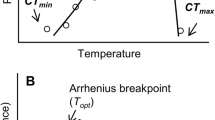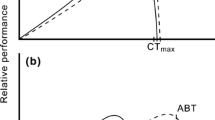Abstract
Studies of sexual selection primarily focus on morphological traits such as body size and secondary trait dimorphism, with less attention been given to the functional differences between the sexes and even more so their thermal performance capacities. Each sex may benefit from possessing different thermal performance capacities that would allow them to maximise their fitness relative to their different reproductive roles; especially when performances are closely related to reproductive success. Here, we examine sexual divergence in thermal sensitivities of performance across three populations of the Asian house gecko (Hemidactylus frenatus) over an extensive latitudinal cline. Using analyses of the thermal sensitivity of routine activity, bite force and sprint speed, we explored whether: (i) males and females differed in their optimal temperatures for performance, (ii) the sexes differed in their thermal sensitivities of performance, and (iii) the degree of sexual divergence in thermal sensitivity varied among the populations. Because male H. frenatus are highly aggressive and frequently engage in combat to gain territories and mating opportunities, we expected males would be active over a wider range of temperatures than females and this would favour broad thermal sensitivity curves for males. In addition, we expected a greater divergence between the sexes in thermal sensitivities for the temperate populations that experience greater daily and seasonal thermal variation. We found that males were more active, and had greater bite forces and faster sprint speeds than females, independent of body size. In addition, we found differences between the sexes in thermal sensitivities for the tropical population; female H. frenatus were less active and possessed lower sprint speeds at higher temperatures than males. Although H. frenatus from the most variable thermal environments also displayed the broadest thermal performance range, it was the more stable tropical population that exhibited the greatest divergence between the sexes in thermal sensitivity of performance. The divergence in thermal physiology that we detected between the sexes of H. frenatus is consistent with the idea that males will derive mating and territorial advantages for maintaining function over a broader range of temperatures.




Similar content being viewed by others
References
Adolf AC, Porter WP (1993) Temperature, activity and lizard life history. Am Nat 142:273–295
Alonso JC, Salgado I, Palacín C (2015) Thermal tolerance may cause sexual segregation in sexually dimorphic species living in hot environments. Behav Ecol 23:1296–1307
Anderson RA, Karasov WH (1988) Energetics of the lizard Cnemidophorus tigris and life-history consequences of food-acuisition mode. Ecol Monogr 58:79–110
Anderson RA, McBrayer LD, Herrel A (2008) Bite force in vertebrates: opportunities and caveats for use of a nonpareil whole-animal performance measure. Biol J Linnean Soc 93:709–720
Andersson M (1994) Sexual selection. Princeton University Press, Princeton
Angilletta MJ (2009) Thermal adaptation: a theroretical and empirical synthesis. Oxford University Press, New York
Angilletta MJ, Montgomery LG, Werner YL (1999) Temperature refernce in geckos: diel variation in juveniles and adults. Herpetologica 55:212–222
Angilletta MJ, Niewiarowski PH, Navas CA (2002) The evolution of thermal physiology in ectotherms. J Therm Biol 27:249–268
Arnold SJ (1983) Morphology, performance and fitness. Amer Zool 23:347–361
Artacho P, Jouanneau I, Le Galliard JF (2013) Interindividual variation in thermal sensitivity of maximal sprint speed, thermal behavior, and resting metabolic tate in a lizard. Physiol Biochem Zool 86:458–469
Asbury DA, Adolph SC (2007) Behavioural plasticity in an ecological generalist: microhabitat use by western fence lizards. Evol Ecol Res 9:801–815
Autumn K, Weinstein RB, Full RJ (1994) Low cost of locomotion increases perormace at low temperature in nocturnal lizard. Physiol Zool 67:238–262
Autumn K. Farley CT, Emshwiller M, Full RJ (1997) Low cost locomotin in the Banded Gecko: a test of the nocturnality hypothesis. Physiol Zool 70:660–669
Bates D, Maechler M, Bolker B (2011) lme4: linear mixed-effects models using Eigen and S4. R package version 1.0-5.3
Bolker BM, Brooks ME, Clark CJ, Geange SW, Poulsen JR, Stevens MHH, White JSS (2009) Generalized linear mixed models: a practical guide for ecology and evolution. Trends Ecol Evol 24:127–135
Cameron SF, Wynn ML, Wilson RS (2013) Sex-specific trade-offs and compensatory mechanisms: bite force and sprint speed pose conflicting demands on the design of geckos (Hemidactylus frenatus). J Exp Biol 216:3781–3789
Cheng HY, Lin JI (1977) Comparative reproductive-biology of lizards, Japalura swinhonis formosensis, Takydromus septentrionalis and Hemidactylus frenatus in Taiwan. 1. Male reproductive-cycle. Bull Inst Zool Acad Sin 16:107–121
Church G (1962) The reproductive cycles of the Javanese house geckos, Cosymnotus platyurus, Hemidactylus frenatus, and Peropus mutilatus. Copeia 1962:262–269
Condon C, Cooper BS, Yeaman S, Angilletta MJ (2014) Temporal variation favors the evolution of generalists in experimental populations of Drosophila melanogaster. Evolution 68–3:720–728
Cooper BS, Czarnoleski M, Angilletta MJ (2010) Acclimation of thermal physiology in natural populations of Drosophila melanogaster: a test of an optimality model. J Evol Biol 23:2346–2355
Crowley SR, Pietruszka RD (1983) Aggressiveness and vocalization in the leopard lizard (Gambelia wislizenni): the influence of temperature. Anim Behav 31:1055–1060
Cullum AJ (1998) Sexual dimorphism in physiological performance of whiptail lizards (genus Cnemidophorus). Physiol Zool 71:541–552
Frenkel C (2006) Hemidactylus frenatus (Squamata: Gekkonidae): call frequency, movement and condition of tail in Costa Rica. Rev Biol Trop 54:1125–1130
Garland T, Losos JB (1994) Ecological morphology of locomotor performance in squamate reptiles. In: Wainwright PC, Reilly SM (eds), Ecological morphology: integrative organismal biology. Univeristy of Chicago Press, Chicago, pp 240–302
Gilchrist GW (1995) Specialists and generalists in changing environments. 1. Fitness landscapes of thermal sensitivity. Am Nat 146:252–270
Gilchrist GW (1996) A quantitative genetic analysis of thermal sensitivity in the locomotor performance curve of Aphidius ervi. Evolution 50:1560–1572
Herrel A, Aerts P, Fret J, de Vree F (1999) Morphology of the feeding system in agamid lizards: Ecological correlates. Anat Rec 254:496–507
Herrel A, James RS, Van Damme R (2007a) Fight versus flight: physiological basis for temperature-dependent behavioral shifts in lizards. J Exp Biol 210:1762–1767
Herrel A, McBrayer LD, Larson PM (2007b) Functional basis for sexual differences in bite force in the lizard Anolis carolinensis. Biol J Linnean Soc 91:111–119
Hitchcock MA, McBrayer LD (2006) Thermoregulation in nocturnal ectotherms: seasonal and intraspecific variation in the Mediterranean gecko (Hemidactylus turcicus). J Herpetol 40:185–195
Hoskin CJ (2011) The invasion and potential impact of the Asian House Gecko (Hemidactylus frenatus) in Australia. Austral Ecol 36:240–251
Hothorn T, Bretz F, Westfall P (2008) Multcomp: simultaneous inference in general parametric models. R package version 1.3-1
Huey RB (1991) Physiological consequences of habitat selection. Am Nat 137:S91-S115
Huey RB, Kingsolver JG (1989) Evolution of thermal sensitivity of ectotherm performance. Trends Ecol Evol 4:131–135
Huey RB, Pianka ER (2007) Natural history miscellany—lizard thermal biology: do genders differ? Am Nat 170:473–478
Huey RB, Stevenson RD (1979) Integrating thermal physiology and ecology of ectotherms: discussion of approaches. Am Zool 19:357–366
Huey RB, Niewiarowski PH, Kaufmann J, Herron JC (1989) Thermal biology of nocturnal ectotherms: is sprint performance of geckos maximal at low body temperatures. Physiol Zool 62:488–504
Irschick DJ, Garland T (2001) Integrating function and ecology in studies of adaptation: investigations of locomotor capacity as a model system. Annu Rev Ecol Syst 32:367–396
Irschick DJ, Le Galliard JF (2008) Studying the evolution of whole-organism performance capacity: sex, selection, and haiku—an introduction. Evol Ecol Res 10:155–156
Izem R, Kingsolver JG (2005) Variation in continuous reaction norms: quantifying directions of biological interest. Am Nat 166:277–289
Kaliontzopoulou A, Bandeira V, Carretero MA (2013) Sexual dimorphism in locomotor performance and its relation to morphology in wall lizards (Podarcis bocagei). J Zool 289:294–302
Kingsolver JG, Huey RB (2008) Size, temperature, and fitness: three rules. Evol Ecol Res 10:251–268
Kuznetsova A, Brunn Brockhoff P, Christensen RHB (2013) lmerTest: test for random and fixed effects for linear mixed effect models (lmer objects of lme4 package). R package version 2.0-3
Lailvaux SP (2007) Interactive effects of sex and temperature on locomotion in reptiles. Integr Comp Biol 47:189–199
Lailvaux SP, Irschick DJ (2007) Effects of temperature and sex on jump performance and biomechanics in the lizard Anolis carolinensis. Funct Ecol 21:534–543
Lailvaux SP, Alexander GJ, Whiting MJ (2003) Sex-based differences and similarities in locomotor performance, thermal preferences, and escape behaviour in the lizard Platysaurus intermedius wilhelmi. Physiol Biochem Zool 76:511–521
Lappin AK, Husak JF (2005) Weapon performance, not size, determines mating success and potential reproductive output in the collared lizard (Crotaphytus collaris). Am Nat 166:426–436
Lees JJ, Nudds RL, Folkow LP, Stokkan KA, Codd JR (2012) Understanding sex differences in the cost of terrestrial locomotion. Proc R Soc B 279:826–832
Lin JY, Cheng HY (1984) Ovarian cycle in the house gecko, Hemidactylus frenatus, in Taiwan with reference to food stress in winter. Bull Inst Zool Acad Sin 23:21–28
Marcellini DL (1971) Activity patterns of gecko Hemidactylus frenatus. Copeia 1971:631–635
Marcellini DL (1974) Acoustic behaviour of the gekkonid lizard, Hemidactylus frenatus. Herpetologica 30:44–52
Marcellini DL (1976) Some aspects of the thermal ecology of the gecko Hemidactylus frenatus. Herpetologica 32:341–345
Marsh RL, Bennett AF (1989) Thermal dependence of sprint performance of the lizard Sceloporus occidentalis. J Exp Biol 126:79–86
Ojanguren AF, Reyes-Gavilan FG, Brana F (2001) Thermal sensitivity of growth, food intake and activity of juvenile brown trout. J Therm Biol 26:165–170
Ota H (1994) Female reproductive-cycles in the nothernmost populations of the 2 Gekkonid lizards, Hemidactylus frenatus and Lepidodactylus lugubris. Ecol Res 9:121–130
Oufiero CE, Garland T (2007) Evaluating performance costs of sexually selected traits. Func Ecol 21:676–689
Petren K, Bolger DT, Case TJ (1993) Mechanisms in the competitve success of an invading sexual gecko over an asexual native. Science 259:354–358
Snell HL, Jennings RD, Snell HM, Harcourt S (1988) Intrapopulation variation in predator-avoidance performance of Galapagos lava lizards: the interaction of sexual and natural-selection. Evol Ecol 2:353–369
Stamps JA, Losos JB, Andrews RM (1997) A comparative study of population density and sexual size dimorphism in lizards. Am Nat 149:64–90
Tang XL, Yue F, He JZ, Wang NB, Ma M, Mo JR, Chen Q (2013) Ontogenetic and sexual differences of thermal biology and locomotor performance in a lacertid lizard, Eremias multiocellata. Zoology 116:331–335
Van Damme R, Bauwens D, Castilla AM, Verheyen RF (1989) Altitudinal variation of the thermal biology and running performance in the lizard Podarcis tiliguerta. Oecol 80:516–524
Van Damme R, Entin P, Vanhooydonck B, Herrel A (2008) Causes of sexual dimorphism in performance traits: a comparative approach. Evol Ecol Res 10:229–250
Vervust B, Brecko J, Herrel A (2011) Temperature effects on snapping performance in the common snapper Chelydra serpentina (Reptilia, Testudines). J Exp Zool Part A 315A:41–47
Wilson RS (2001) Geographic variation in thermal sensitivity of jumping performance in the frog Limnodynastes peronii. J Exp Biol 204:4227–4236
Wilson SK, Swan G (2008) A complete guide to reptiles of Australia. New Holland Publishers, Sydney
Yu X, Peng Y, Aowphol A, Ding L, Brauth SE, Tang YZ (2011) Geographic variation in the advertisement calls of Gekko gecko in relation to variations in morphological features: implications for regional population differentiation. Ethol Ecol Evol 23:211–228
Zajitschek SRK, Zajitschek F, Miles DB, Clobert J (2012) The effect of coloration and temperature on sprint performance in male and female wall lizards. Biol J Linnean Soc 107:573–582
Zuur AF, Ieno EN, Walker NJ, Saveliev AA, Smith GM (2009) Mixed effects models and extensions in ecology with R. Springer, New York
Acknowledgements
We thank G. David and T. Shuey for help with gecko collection. We also thank C. White and D. Booth and anonymous reviewers for valuable discussions and feedback. This work was supported by an Ecological Society of Australia Student Research Grant. All experiments were approved under the University of Queensland’s Animal Ethics Committee (AEC Approval Number-SBS/319/09).
Author information
Authors and Affiliations
Corresponding author
Additional information
Communicated by I. D. Hume.
Appendix
Appendix
Rights and permissions
About this article
Cite this article
Cameron, S.F., Wheatley, R. & Wilson, R.S. Sex-specific thermal sensitivities of performance and activity in the asian house gecko, Hemidactylus frenatus. J Comp Physiol B 188, 635–647 (2018). https://doi.org/10.1007/s00360-018-1149-2
Received:
Revised:
Accepted:
Published:
Issue Date:
DOI: https://doi.org/10.1007/s00360-018-1149-2




